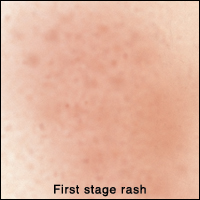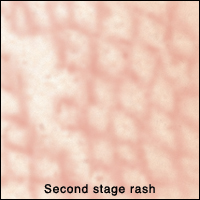When Your Child Has Fifth Disease
When Your Child Has Fifth Disease
Fifth disease (erythema infectiosum) is a viral infection that is common in children. Fifth disease is also known as slapped cheek disease. This is due to the bright red facial rash that is one of the signs of the infection. Fifth disease usually goes away on its own with no lasting problems.
Pregnancy and fifth disease
Pregnant women should talk with their healthcare provider before having contact with a child who has fifth disease. The virus that causes fifth disease may harm an unborn child.
Why is it called fifth disease?
In the past, erythema infectiosum was number 5 on a list of childhood infections that cause rashes.
What causes fifth disease?
Fifth disease is caused by a virus called parvovirus B19. The virus is spread by droplets in the air when someone who is infected sneezes or coughs. Most children with fifth disease catch it at school or daycare. The virus can spread from person to person (is contagious) in its early stages, before the rash appears. Fifth disease is most common in school-age children, but can develop at any age.
What are the symptoms of fifth disease?
Fifth disease has 3 stages:
First stage. The earliest stage of fifth disease (the prodomal stage) consists of a low fever, headache, sore throat, muscle aches, chills, or respiratory symptoms. This often looks like a mild cold. Your child may feel tired, cranky, or rundown. This stage may come and go before you notice it.
Second stage. This is when the facial rash appears, a few days to a week or more after the prodromal symptoms. The rash appears bright rosy red on the cheeks. Your child may also look pale around the mouth because the cheeks are so red. This first rash fades in a few days.
Third stage. A rash appears on your child’s arms, legs, and torso. This second rash is flat, purple-red, and looks lacy. It is painless, but may be slightly itchy. The second rash may take 1 to 3 weeks to go away entirely. It may get better or worse during this time.
How is fifth disease diagnosed?
Your child's healthcare provider may do a blood test to check for the virus. However, it is usually diagnosed by the appearance of the distinctive rash. In some cases, tests may be done to rule out other health problems.
How is fifth disease treated?
Fifth disease needs no treatment. It will go away on its own. To help your child feel better until it does:
Be sure he or she gets plenty of rest and fluids.
Your child’s healthcare provider may suggest giving children’s strength over-the-counter (OTC) medicines to help relieve fever or discomfort. Note: Don’t give OTC cough and cold medicines to a child younger than 6 years old, unless your child's provider tells you to do so.
Don’t give your child aspirin. Using aspirin in children could cause a serious condition called Reye syndrome.
Don’t give ibuprofen to an infant age 6 months or younger.
An anti-itch medicine called an antihistamine may be recommended if the rash is itchy.
Returning to school
Once your child develops the rash, he or she is no longer contagious and may go school or day care. A child who still has a fever should not go to school or daycare.
What are the long-term concerns?
Once your child has had fifth disease, he or she will usually not have it again. Fifth disease rarely causes problems in children who are otherwise healthy.
When to seek medical care
Call your child’s healthcare provider right away if your otherwise healthy child has any of the following:
Fever, as directed by your child’s healthcare provider, or:
Your child is younger than 12 weeks and has a fever of 100.4°F (38°C) or higher.
Your child has repeated fevers above 104°F (40°C) at any age.
Your child is younger than 2 years old and the fever lasts for more than 24 hours.
Your child is 2 years old or older and the fever lasts for more than 3 days.
A seizure caused by the fever
Severe muscle or joint aches and pains with the rash or fever
Rash that doesn’t clear up after a few weeks
Updated:
March 28, 2018
Reviewed By:
Bass, Pat F. III, MD, MPH,Lentnek, Arnold, MD

